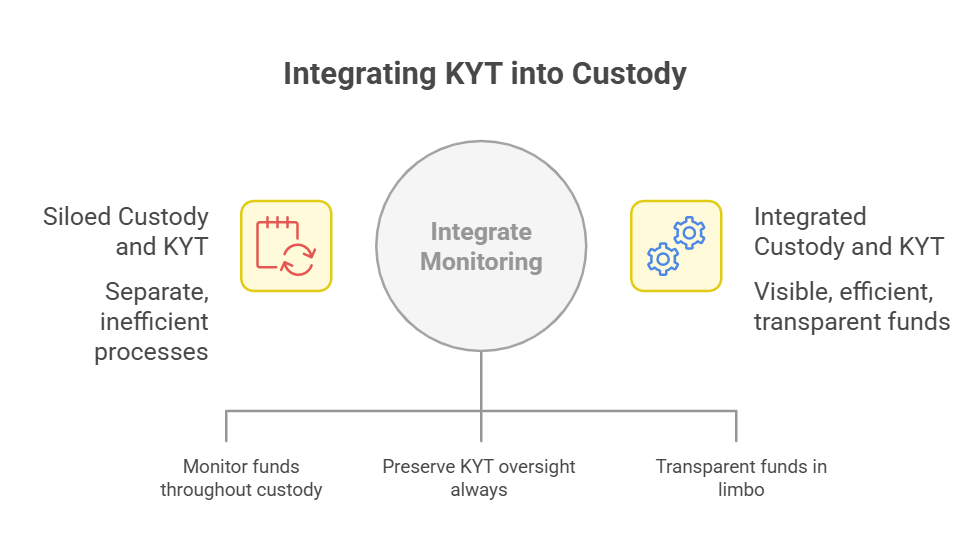Overview
The global crypto market is standing at the crossroads of two regulatory forces that, until recently, were treated as separate tracks: custody requirements and KYT (Know Your Transaction) obligations.
Their collision is fast becoming one of the most pressing operational challenges for exchanges, OTC desks, liquidity providers, and ramps worldwide.

In the early years of digital assets, custody was treated loosely. Pre-funding arrangements, where a client wires crypto before a trade executes, were common practice. The assumption was simple: these funds were just “in transit.”
Regulators now disagree.
- In Europe, ESMA’s MiCA guidance makes clear that if a client’s assets leave their wallet before execution, this constitutes custody. Only licensed custodians can handle them.
- In the United States, custody is already broadly defined under SEC rules, pulling crypto into broker-dealer and investment adviser frameworks.
- Singapore, Hong Kong, UAE, and beyond also mandate explicit custody licences, even if the holding is short-term or linked to settlement.
Regulators want full transaction transparency through KYT, continuous monitoring of wallets and flows to spot money laundering, sanctions evasion, or terrorist financing.
But custody rules and KYT expectations don’t line up neatly:
- Visibility gaps: When assets move into omnibus or third-party wallets, KYT systems lose the ability to see who owns what during that interim stage.
- Delayed checks: If monitoring only resumes after settlement, tainted funds may already be mixed with clean liquidity.
- Blurry accountability: Who is supposed to run the checks while the funds are sitting in custody, the venue, the custodian, or the counterparty?
This friction between custody obligations and KYT expectations is quickly emerging as one of the toughest operational problems in global crypto markets. Custody rules are designed to protect investors by dictating who can hold assets and under what safeguards.
KYT frameworks, on the other hand, are built to follow assets wherever they travel, flagging risks and illicit flows in real time. The two systems don’t always align, leaving market participants stuck trying to satisfy both without dismantling the speed and efficiency that make digital assets attractive in the first place.
Solving this challenge requires new thinking. The industry cannot afford to treat custody and KYT as separate silos. Custodians will need to integrate monitoring directly into their infrastructure, ensuring that funds remain visible and screened throughout the custody process. Trading venues must design settlement flows that preserve KYT oversight even during pre-funding. At the same time, innovations such as smart contracts based escrow or atomic swaps offer a glimpse of how technology can keep “funds in limbo” transparent without sacrificing efficiency.

Final thoughts
The collision between custody and KYT is not a theoretical debate, it is reshaping the mechanics of crypto markets in real time. Firms that treat custody as just a licensing hurdle, or KYT as just another compliance add-on, will be blindsided.
The future belongs to those who understand that custody and KYT are no longer separate silos. They are converging into a single operational reality: client assets must be both safeguarded and continuously monitored, from the moment they leave the wallet until the trade is complete.
This convergence may feel like friction today, but it is also the foundation of a safer, more transparent digital asset ecosystem tomorrow.
Custody Rules and KYT Expectations: FAQs
Q. How does this affect smaller crypto businesses compared to large exchanges?
Large exchanges may already have the resources to apply for custody licences or partner with established custodians. Smaller firms, however, may struggle with the added costs and compliance requirements, which could push them out of certain markets or force consolidation.
Q. Could technology solve the custody- KYT conflict?
Yes, at least partly. Tools like atomic swaps, escrow smart contracts, and integrated monitoring systems can keep assets visible and compliant without relying on traditional pre-funding. But these solutions are still developing and not yet widely adopted at scale.



%20thumbnail%20.jpg)

%20(1).png)
%20(2).jpg)